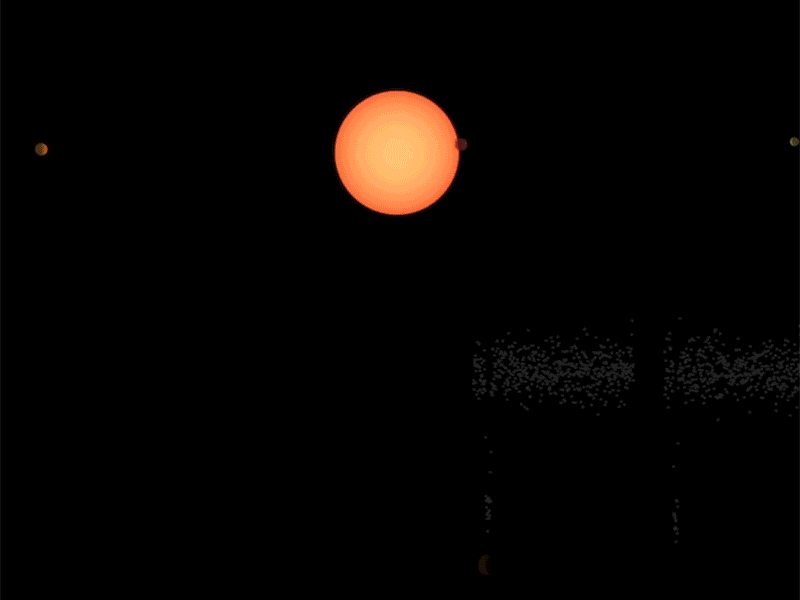
On March 21, NASA announced the confirmation of the 5,000th planet outside our Solar System. From scorching-hot gas giants nestled near their parent star to rocky worlds that may host water on their surface, there’s a variety for scientists to study.
But finding these strange new worlds is a science in itself. We’ve only been able to definitively detect planets of any kind for a few decades, and even at that, there are challenges in detecting such a small object at that distance in even the most powerful telescopes.
Inverse spoke with Marie-Eve Naud, an exoplanet researcher and outreach coordinator for the University of Montreal’s Institute for Research on Exoplanets, to tell us more about how astronomers find these worlds and the considerations for each method. While there are numerous methods, the ones cited below are the most common.

The transit method
Astronomers have found most of the known exoplanets through the transit method, first demonstrated in 1999 to confirm the existence of planet HD 209458b. NASA’s Kepler space telescope, launched in 2009, detected thousands of planets in a fixed patch of sky near the constellation Cygnus. As the planets passed across the face of their star, they slightly diminished the starlight. These changes in light levels are detectable to instruments called photometers.
For this method to work, astronomers must detect a tiny change in the inherent brightness (luminosity) of the star, often less than one percent. In space, that is easier to accomplish due to the lack of atmosphere interfering with observations and is the preferred method for missions such as the European Space Agency’s Characterising Exoplanet Satellite (Cheops) and NASA’s Transiting Exoplanet Survey Satellite (TESS).
Naud cautioned that multiple detections are required, meaning a planet must be seen across several orbits to ensure the dimming light isn’t due to sunspots or dust. “You usually wait until you've seen two or three transits,” she said, emphasizing that astronomers want a large amount of data from the transit method before confirming a planet is there.
Once a planet is detected, astronomers can estimate its radius. Astronomers must find the mass separately (often through the radial velocity method, detailed below.) If astronomers can determine the mass and radius of a planet, they can determine if it is likely rocky or gaseous, which has significant implications for life.
If they find the planet to be rocky and in a zone of the parent star that can host water, for example, they might consider it habitable. But there are complications, such as whether the planet is close to a star that often erupts, like a red dwarf. Constant eruptions shower a world in radiation and threaten any emergent microbes. That’s why astronomers are unsure if TRAPPIST-1, for example, hosts any habitable exoplanets even though astronomers have found seven Earth-sized ones in this system, and a few are in the habitable zone.

Radial-velocity method
Radial velocity is a common way of finding planets, especially with observatories such as the High Accuracy Radial velocity Planet Searcher (HARPS) instrument at the European Southern Observatory’s La Silla 3.6m telescope in Chile.
“We often say that the planet orbits around the star, but in fact, both objects are based around their center of mass,” Naud explained. “That star is slightly moving, if it has a planet. If it has many, it will have a complex motion.”
The key is looking at the spectrum of the star. As the star moves towards us, its light is compressed, and the spectrum shifts to red. As the star moves away, its light is stretched, and the spectra shifts to blue. The star’s spectrum is slightly affected by the planet's motion, making it “kind of a barcode of the star,” Naud explained.
The first detection of a planet around a Sun-like star with this method occurred in 1995 when Didier Queloz and Michel Mayor published their findings on 51 Pegasi b. But it wasn’t the first-ever detection of a planet — two were reported around pulsar PSR B1257+12 in 1992, with a third planet confirmed in 1994. Astronomers Aleksander Wolszczan and Dale Frail detected the planets through intermittent changes in the pulsar’s radio signal, corresponding with an orbiting planet passing between the pulsar and Earth. It shows you the variety of scientific means by which we can find different worlds.

Direct imaging
Direct imaging allows scientists to remove the light from a star to see exoplanets directly. You may think this is an easy method, but it’s more complicated than it sounds. Given that these planets are pretty small and have relatively little reflected light for a telescope to see, the technique is still tricky for astronomers to accomplish with current telescope technology. That’s why astronomers have only found 60 or so planets with this technique so far.
Still, there are benefits: “It's the only method that allows direct detection of exoplanets,” Naud said. While these planets are points of light for now, we may be able to see more detail in their atmospheres and on their surfaces in the far future.
There are two primary methods scientists use to do direct imaging today. The first, coronagraphy, blocks the light from the star’s outermost layer (or corona) using a device inside the telescope called a coronagraph to create an artificial eclipse to spot planets.
For example, Canada’s Gemini Planet Imager is installed on the 8.1-meter telescope at the Gemini South Observatory, Cerro Pachon, Chile. Using a coronagraph, it found the first known "young Jupiter," 51 Eri b, in August 2015. (Naud said GPI is considered a pioneer in direct imaging.)
The second method is a starshade, which blocks light from a star before it moves inside the telescope. Starshades designed for exoplanets need to be a separate spacecraft from a telescope to ensure they have the proper distance and angle to block the starlight effectively, unlike starshades used to shield from the light of our star like the one built on the James Webb Space Telescope. To date, a starshade hasn’t flown in space.

Gravitational microlensing
While astronomers have detected a significant minority of planets (130+ at this writing) with a technique called microlensing, the observations are hard to follow up. The trouble is we often see these worlds only once. That’s because they use a phenomenon, first described by Einstein, where a large foreground object (like a star or galaxy) bends the light of a much smaller object behind. Since these alignments in the sky are brief and can’t be predicted, this often means we cannot examine a particular planet again.
“It’s a bit frustrating, because it happens once when you have a perfect alignment with a background object,” Naud said, cautioning it’s challenging to establish the work for future studies “because we’ve seen it just that one time.”
The alignment changes slightly when a planet — which has gravity of its own — gets involved. The planet’s gravity adds an additional lensing event to the star’s light, brightening the image of the background star and allowing astronomers to learn a lot about that planet, including its mass and orbital period despite the fleeting nature of the event.
Astronomers first detected a planet with this method in 2003. The detection combined the capabilities of the Polish Optical Gravitational Lensing Experiment (OGLE) which examines star variability, with the Japanese/New Zealand Microlensing Observations in Astrophysics (MOA). The microlensing event is known as 2003-BLG-235 and was likely a planet 1.5 times the mass of Jupiter.
The most distant confirmed microlensed planet is MOA-2011-BLG-291L b, located 28,700 light years away. However, there is circumstantial evidence for planets outside our galaxy, but because microlensing events are so fleeting, it is impossible to confirm them.

Astrometry
Astrometry tracks offsets in the position of a star produced by an orbiting exoplanet. Because stars and their planets orbit a barycenter, astronomers can detect the wobble of a star caused by a planet with extremely precise instruments. The technique is quite difficult as it relies on even more precise observations than radial velocity and has been the source of several controversial claims.
A notorious example of the difficulties of astrometry for exoplanet discoveries came in 1963. Swarthmore College astronomer Peter van de Kamp announced that he had found a planet around Barnard's Star using Swarthmore’s 24-inch refractor at Sproul Observatory. It turned out that adjustments to the telescope’s primary mirror had produced a spurious signal, and the exoplanets didn’t exist.
The European Space Agency’s Gaia mission, which precisely charts the positions of stars from space, is expected to use astrometry to seek out exoplanets. The next release of data, anticipated later this year, may include the first astrometric exoplanet detections.
The NASA Exoplanet Archive only lists one planet found by astrometry: DENIS-P J082303.1-491201b, also known as VB 10b. As the planet (or brown dwarf, depending on the source consulted) did not show up in follow-up radial velocity observations, however, “most researchers consider it another false positive,” according to the Planetary Society. That’s because scientists generally prefer to have at least two detections of a planet to confirm its existence.
The future of exoplanet hunting
While near future detections of planets will likely use variations of the above methods, some further-out ideas may allow us to look at other worlds with more detail. One idea, for example, is to use the Sun as a gravitational lens. A spacecraft, however, would need to travel to 550 Sun-Earth distances to effectively use it, which is seven or eight times further than the Voyager spacecraft are from Earth.
On the ground, scientists are looking forward to the first light of the Extremely Large Telescope, a European observatory expected to take direct images of some planets and characterize their atmospheres better. It is scheduled to start work in 2027.







